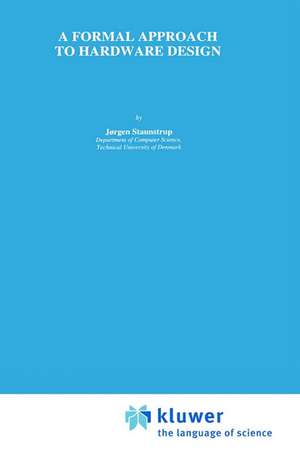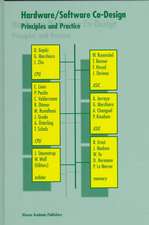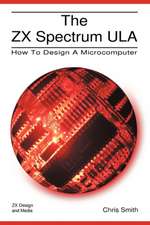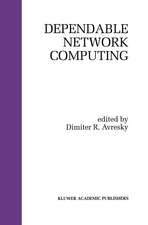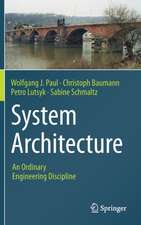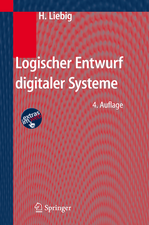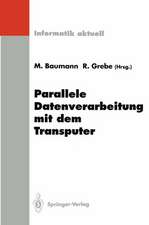A Formal Approach to Hardware Design: The Springer International Series in Engineering and Computer Science, cartea 253
Autor Jørgen Staunstrupen Limba Engleză Hardback – 31 ian 1994
Synchronized Transitions is supported by a collection of public domain CAD tools. These tools can be used with the book in presenting a course on the subject.
A Formal Approach to Hardware Design illustrates the benefits to be gained from adopting such techniques, but it does so without assuming prior knowledge of formal design methods. The book is thus not only an excellent reference, it is also suitable for use by students and practitioners.
| Toate formatele și edițiile | Preț | Express |
|---|---|---|
| Paperback (1) | 942.44 lei 6-8 săpt. | |
| Springer Us – 9 oct 2012 | 942.44 lei 6-8 săpt. | |
| Hardback (1) | 950.52 lei 6-8 săpt. | |
| Springer Us – 31 ian 1994 | 950.52 lei 6-8 săpt. |
Din seria The Springer International Series in Engineering and Computer Science
- 24%
 Preț: 1041.98 lei
Preț: 1041.98 lei - 20%
 Preț: 643.50 lei
Preț: 643.50 lei - 18%
 Preț: 1225.62 lei
Preț: 1225.62 lei - 18%
 Preț: 965.02 lei
Preț: 965.02 lei - 20%
 Preț: 646.12 lei
Preț: 646.12 lei - 18%
 Preț: 948.79 lei
Preț: 948.79 lei - 20%
 Preț: 646.62 lei
Preț: 646.62 lei - 15%
 Preț: 637.46 lei
Preț: 637.46 lei - 20%
 Preț: 643.83 lei
Preț: 643.83 lei - 18%
 Preț: 949.23 lei
Preț: 949.23 lei - 20%
 Preț: 644.48 lei
Preț: 644.48 lei - 20%
 Preț: 994.92 lei
Preț: 994.92 lei - 20%
 Preț: 645.97 lei
Preț: 645.97 lei - 18%
 Preț: 946.87 lei
Preț: 946.87 lei - 20%
 Preț: 995.57 lei
Preț: 995.57 lei - 18%
 Preț: 956.99 lei
Preț: 956.99 lei - 20%
 Preț: 644.98 lei
Preț: 644.98 lei - 15%
 Preț: 649.54 lei
Preț: 649.54 lei - 18%
 Preț: 950.21 lei
Preț: 950.21 lei - 18%
 Preț: 1221.38 lei
Preț: 1221.38 lei - 18%
 Preț: 957.62 lei
Preț: 957.62 lei - 15%
 Preț: 643.99 lei
Preț: 643.99 lei - 18%
 Preț: 948.47 lei
Preț: 948.47 lei - 18%
 Preț: 947.35 lei
Preț: 947.35 lei - 20%
 Preț: 1284.65 lei
Preț: 1284.65 lei - 20%
 Preț: 1628.31 lei
Preț: 1628.31 lei - 20%
 Preț: 1285.78 lei
Preț: 1285.78 lei
Preț: 950.52 lei
Preț vechi: 1159.17 lei
-18% Nou
Puncte Express: 1426
Preț estimativ în valută:
181.90€ • 197.52$ • 152.80£
181.90€ • 197.52$ • 152.80£
Carte tipărită la comandă
Livrare economică 22 aprilie-06 mai
Preluare comenzi: 021 569.72.76
Specificații
ISBN-13: 9780792394273
ISBN-10: 0792394275
Pagini: 232
Ilustrații: XIV, 232 p.
Dimensiuni: 155 x 235 x 24 mm
Greutate: 0.59 kg
Ediția:1994
Editura: Springer Us
Colecția Springer
Seria The Springer International Series in Engineering and Computer Science
Locul publicării:New York, NY, United States
ISBN-10: 0792394275
Pagini: 232
Ilustrații: XIV, 232 p.
Dimensiuni: 155 x 235 x 24 mm
Greutate: 0.59 kg
Ediția:1994
Editura: Springer Us
Colecția Springer
Seria The Springer International Series in Engineering and Computer Science
Locul publicării:New York, NY, United States
Public țintă
ResearchCuprins
1 Formal Design Methods.- 1.1 Why Use Formal Methods?.- 1.2 Models of Integrated Circuits.- 1.3 Synchronized Transitions.- 1.4 Background.- 2 DESIGNING WITH TRANSITIONS.- 2.1 Computational Model.- 2.2 States.- 2.3 Transitions.- 2.4 Arrays and Quantification.- 2.5 Fixed Points.- 2.6 Statics.- 2.7 Named Transitions.- 2.8 Cells.- 2.9 Conditional Instantiation.- 2.10 Restricting State Variables.- 2.11 Other Constructs.- 2.12 Background.- 2.13 Exercises.- 3 Formal Verification.- 3.1 Invariants and Protocols.- 3.2 Verification of Invariants and Protocols.- 3.3 Mechanical Verification.- 3.4 Verification of Modular Designs.- 3.5 Background.- 3.6 Exercises.- 4 Synchronous Designs.- 4.1 The Synchronous Combinator.- 4.2 Verification of Synchronous Designs.- 4.3 A Fast Adder.- 4.4 Background.- 4.5 Exercises.- 5 Synchronous Realizations.- 5.1 Two-phase Realizations.- 5.2 Timing Estimation.- 5.3 Asynchronous Designs.- 5.4 Implementation Conditions.- 5.5 Background.- 5.6 Exercises.- 6 Refinement.- 6.1 Abstraction Functions.- 6.2 The Weak Refinement Condition.- 6.3 Mechanization.- 6.4 Interface Refinement.- 6.5 Background.- 6.6 Exercises.- 7 Self-Timed Circuits.- 7.1 Classification.- 7.2 Models of Self-timed Circuits.- 7.3 Speed-independence.- 7.4 Hierarchical Designs.- 7.5 Delay-insensitivity.- 7.6 Background.- 7.7 Exercises.- 8 Towards Larger Designs.- 8.1 Combining Asynchronous and Synchronous Computations.- 8.2 Codesign.- 8.3 Background.- 9 EPILOG.- A Synchronized Transitions Report.- References.
